RHINELAND CAMPAIGN DELAYS CAPTURE OF GERMANY’S RUHR
SHAEF HQ, Versailles, France • March 10, 1945
On this date in 1945 three sets of battles fought during the final stages of the European war ended in Allied victories and marked the beginning of the Allied invasion of Nazi Germany. The Battle of the Reichswald (German, Imperial Forest), known also as Operation Veritable, was conducted by Gen. Sir Harry Crerar’s First Canadian Army assisted by the British XXX Corps under Lt. Gen. Sir Brian Horrocks; these troops—470,000 strong—formed the northern arm of a pincer movement into the enemy’s Rhineland. The southern arm of the pincer movement was called Operation Grenade and was an offensive by the U.S. Ninth Army, commanded by Lt. Gen. William Hood Simpson. Both the British-Canadian forces and the U.S. Ninth Army operated under Field Marshal Bernard Law Montgomery’s 21st Army Group.
Defended by 11,000 enemy soldiers, the forested Reichswald assault area was a narrow four-to-five-mile gap between two rivers, the Maas and the giant Rhine, and was the natural advance from the Dutch-German border to the Ruhr region, the industrial heart of Germany (see map below). It also was the right flank of the German Westwall (Siegfried Line) fortifications that ran from the Reichswald to the border with Switzerland. To the south Simpson’s Ninth Army would strike across the Roer River and become the anvil for the British and Canadians blasting out of the Reichswald, which they eventually did on February 22 under a new name, Operation Blockbuster. In support of the Reichswald assault were some 1,050 artillery pieces of various caliber, a half-million artillery shells, a dozen 32‑barrel rocket launchers, 80 4.2‑in mortars, 60 Sherman tanks equipped with 75mm cannons, and Achilles tank destroyers whose main armament was a 17‑pounder, 3‑in gun mounted in an open turret. Overhead flew sorties of heavy, medium, and fighter bombers of British and U.S. air forces, leaving the nearby towns of Cleves and Goch piles of rubble.
No east-west hard-surface route passed through the Reichswald, crimping the passage of British-Canadian fighting men and armor to the Ruhr objective. Besides, the flooded Rhine and Maas flood plains necessitated the use of Buffalo amphibious vehicles and breaching three enemy defensive systems. Despite the negative impediments to moving in the Rhineland, the Battle of the Reichswald (Operation Veritable) began on February 8, 1945, powered by 200,000 infantrymen, 500 tanks, including Churchill Crocodile flamethrowers and Sherman Flails that beat the ground in front of them with whirling chains to set off mines, and 500 specialized vehicles such as Buffalos. On Days 2 and 3 the Germans released water from the Roer and Urft dams. The Roer River rose five feet, forcing Operation Grenade’s U.S. Ninth Army (the southern pincer arm and hence the anvil) to stay in place on the west bank and take no military action for 2 weeks.
The British-Canadian northern pincer arm was stymied also by the appearance of German reinforcements that sorely lacked armor—armor destroyed in the Battle of the Bulge weeks before. Once the Reichswald had been penetrated on February 22, Operation Blockbuster swung into action in concert with Operation Grenade when American forces were able to cross the still turbulent Roer the next day. The combined armies attacked German divisions under Field Marshal Gerd von Rundstedt that remained on the west bank of the Rhine in accordance with Adolf Hitler’s orders to hold the line. Fighting continued as the Germans sought to retain a bridgehead on the west bank of the Rhine at Wesel and evacuate as many men and as much equipment as possible. Finally, on March 10, 1945, the German withdrawal ended and the last Rhine bridges were destroyed. In the bitter slugging match, the Allies managed to capture 230,000 enemy prisoners, second only in number to the 317,000 mostly unarmed German soldiers who were ensnared in the Ruhr Pocket between April 1 and April 18, 1945.
Allies’ Rhineland Campaign Opens with Battle of the Reichswald (Operation Veritable), February 8–22, 1945
 |
Above: Operations Veritable (Battle of the Reichswald) and Blockbuster (top third of map) and Operation Grenade (second third of map) took place in West-Central Germany and Belgium. The joint British-Canadian and U.S. Rhineland Campaign, whose objectives were to break through Germany’s defensive Westwall (Siegfried Line) and seize the Ruhr region—the industrial heart of Nazi Germany—lasted just over a month, from February 8 to March 10, 1945, and was agonizingly slow. Casualties were heavy on both sides (Allied: 15,634 vs. German: ~44,239) as the effort to reach the Ruhr bogged down in the face of tough German resistance, appalling weather, water-covered roads, and deep mud.
 |  |
Left: During preparations for kicking off the Battle of the Reichswald (Operation Veritable), the British Royal Air Force launched heavy raids against Rhineland cities and towns in the anticipated path of the British-Canadian advance toward the Ruhr. Cleves (Kleve), which appears near the top of the map (above), was the home of Henry VIII’s fourth wife, Anne, and was hit by RAF bombers on February 7–8 with devastating results. Over 90 percent of its buildings were severely damaged in the air raids. This was followed by two 2‑1/2 hour, ear-splitting artillery barrages that continuously shook the ground forward of the field guns, leaving soldiers unable to hear each other. “Piles of smashed furniture, clothing, children’s books and toys, old photographs and bottled fruit, were spilled in hopeless confusion from the sagging crazy skeletons of houses,” said one report. The photo above shows British infantrymen, maybe from the 43rd Wessex or 15th Scottish Divisions, part of XXX Corps, advancing in cold mist on a rain-sodden road through Cleves south toward Goch, February 16, 1945.![]()
Right: A Valentine Mk XI Royal Artillery OP (Observation Post) tank (left) and a Churchill tank (right) in Goch, February 21, 1945. Goch was a major link in the Germans’ Westwall (Siegfried Line) and was planned as Operation Veritable’s final objective. The town was well fortified with many pillboxes on the flooded River Niers to the east of Goch on one side and an antitank ditch covering the other three sides. Most of the town was in ruins from previous heavy bombardment and its streets deeply cratered or choked with rubble; however, many empty cellars and the gardens behind the ruined buildings were converted into mortar batteries and sniper nests. On February 19 Goch came under determined attack by the British 51st Highland Division, but by the third day the badly shaken defenders had been routed, adding more than 240 men to the 12,000 Germans taken prisoner so far, to say nothing of the many thousands of dead and wounded. At Veritable’s conclusion, the British-Canadian offensive, reborn Operation Blockbuster, linked up with the U.S. Ninth Army (Operation Grenade) heading for a Rhine crossing in the last stand-up fight between the Western Allies and the Germans, the Battle of the Ruhr Pocket (April 1–18, 1945).
First Canadian Army Attacks German Town of Cleves, February 1945. Silent archive film
![]()

 History buffs, there is good news! The Daily Chronicles of World War II is now available as an ebook for $4.99 on Amazon.com. Containing a year’s worth of dated entries from this website, the ebook brings the story of this tumultuous era to life in a compelling, authoritative, and succinct manner. Featuring inventive navigation aids, the ebook enables readers to instantly move forward or backward by month and date to different dated entries. Simple and elegant! Click
History buffs, there is good news! The Daily Chronicles of World War II is now available as an ebook for $4.99 on Amazon.com. Containing a year’s worth of dated entries from this website, the ebook brings the story of this tumultuous era to life in a compelling, authoritative, and succinct manner. Featuring inventive navigation aids, the ebook enables readers to instantly move forward or backward by month and date to different dated entries. Simple and elegant! Click 











